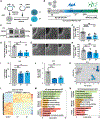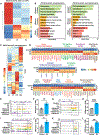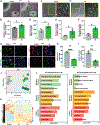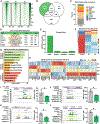Requirements for the neurodevelopmental disorder-associated gene ZNF292 in human cortical interneuron development and function
- PMID: 40257863
- PMCID: PMC12283078
- DOI: 10.1016/j.celrep.2025.115597
Requirements for the neurodevelopmental disorder-associated gene ZNF292 in human cortical interneuron development and function
Abstract
Pathogenic mutation of the zinc-finger transcription factor ZNF292 is a recently defined contributor to human neurodevelopmental disorders (NDDs). However, the gene's roles in cortical development and regulatory networks under its control were previously undefined. Here, human stem cell models of ZNF292 deficiency, resembling pathogenic haploinsufficiency, are used to derive cortical inhibitory neuron progenitors and neurons. ZNF292-deficient progenitors undergo precocious differentiation but subsequently exhibit compromised interneuron maturation and function. In progenitors, genome-wide occupancy and transcriptomic analyses identify direct target genes controlling neuronal differentiation and synapse formation that are upregulated upon ZNF292 deficiency. By contrast, deficiency in interneurons compromises ZNF292 genome-wide association with and causes downregulation of direct target genes promoting interneuron maturation and function, including other NDD genes. ZNF292-deficient interneurons also exhibit altered channel activities, elevated GABA responsiveness, and hallmarks of neuronal hyperactivity. Together, the results of this work define neurodevelopmental requirements for ZNF292, some of which may contribute to pathogenic ZNF292 mutation-related NDDs.
Keywords: CP: Developmental biology; CP: Neuroscience; autism; cortical interneuron differentiation; cortical neuron; electrophysiological function; genome-wide occupancy; human pluripotent stem cell; neurodevelopmental disorders; transcriptional regulation; zinc-finger transcription factor.
Copyright © 2025 The Author(s). Published by Elsevier Inc. All rights reserved.
Conflict of interest statement
Declaration of interests The authors declare no competing interests.
Figures







Similar articles
-
Autism- and intellectual disability-associated MYT1L mutation alters human cortical interneuron differentiation, maturation, and physiology.Stem Cell Reports. 2025 Mar 11;20(3):102421. doi: 10.1016/j.stemcr.2025.102421. Epub 2025 Feb 27. Stem Cell Reports. 2025. PMID: 40020682 Free PMC article.
-
The chromatin remodeler ADNP regulates neurodevelopmental disorder risk genes and neocortical neurogenesis.Proc Natl Acad Sci U S A. 2025 Jan 21;122(3):e2405981122. doi: 10.1073/pnas.2405981122. Epub 2025 Jan 14. Proc Natl Acad Sci U S A. 2025. PMID: 39808658 Free PMC article.
-
Short-Term Memory Impairment.2024 Jun 8. In: StatPearls [Internet]. Treasure Island (FL): StatPearls Publishing; 2025 Jan–. 2024 Jun 8. In: StatPearls [Internet]. Treasure Island (FL): StatPearls Publishing; 2025 Jan–. PMID: 31424720 Free Books & Documents.
-
Out of Line or Altered States? Neural Progenitors as a Target in a Polygenic Neurodevelopmental Disorder.Dev Neurosci. 2024;46(1):1-21. doi: 10.1159/000530898. Epub 2023 May 10. Dev Neurosci. 2024. PMID: 37231803 Free PMC article. Review.
-
Management of urinary stones by experts in stone disease (ESD 2025).Arch Ital Urol Androl. 2025 Jun 30;97(2):14085. doi: 10.4081/aiua.2025.14085. Epub 2025 Jun 30. Arch Ital Urol Androl. 2025. PMID: 40583613 Review.
References
-
- Chen J, Lambo ME, Ge X, Dearborn JT, Liu Y, McCullough KB, Swift RG, Tabachnick DR, Tian L, Noguchi K, et al. (2021). A MYT1L syndrome mouse model recapitulates patient phenotypes and reveals altered brain development due to disrupted neuronal maturation. Neuron 109, 3775–3792.e14. 10.1016/j.neuron.2021.09.009. - DOI - PMC - PubMed
MeSH terms
Substances
Grants and funding
LinkOut - more resources
Full Text Sources
Miscellaneous

